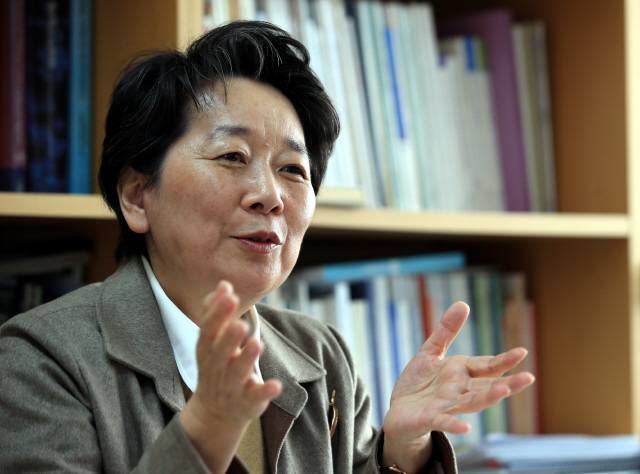Posted on : Mar.23,2016 16:58 KSTModified on : Mar.23,2016 16:58 KST
 |
Seoul National University College of Natural Sciences biological sciences professor Roe Jung-hye during an interview at her office on Mar. 22. (by Kim Tae-hyeong, staff photographer)
|
Incoming committee chairperson aims to create a campus atmosphere of creative cooperation
The glass ceiling for women who leave their jobs to raise families isn’t just a company phenomenon - it’s happening in universities too. In an interview at her office in the Seoul National University College of Natural Sciences on Mar. 22, biological sciences professor Roe Jung-hye stressed the continuing low representation of women in engineering, saying, “When the percentage of qualified women who can’t get a job simply because of their gender is very high, doesn‘t that mean something needs to be fixed? This isn’t a climate where men or women can freely use childcare leave, be it in the workplace or in schools.”
She continued, “They talk about how women have more of a voice now, but the numbers show that‘s not true. Even in schools, there’s a hidden prejudice that women will quit along the way or not do a good job because of children and home issues.”
Women accounted for 302 of SNU’s 2,075 professors, or 14.6%, as of Apr. 2015. Not only does the percentage fall short of the 27-28% rate at Harvard and Stanford, but it’s also below the 20% recommended by the South Korean government, and the 24.6% average for private universities. At the same time, the percentage of women in non-full-time educational positions, including hourly lecturers and research professors, is 37.3%. Female students account for over 40% of SNU undergrads, but women professors are still a minority.
Roe is now set to assume the position of chairperson of SNU‘s diversity committee, which is set to launch on Mar. 23. Established as a way of increasing and maintaining campus diversity, it has set the priority task of expanding the employment of female and foreign professors and non-SNU alumni. In Roe’s view, a crucial part of this is creating a culture where studies can be balanced with childbirth and child-rearing from the graduate curriculum onward.
Another of the diversity committee‘s goals is to create an open campus atmosphere and culture conducive to “creative cooperation.” The members’ feeling is that while it is important to make sure students, faculty members, and other members of the university family excel in intelligence, there also needs to be a climate where they can collaborate in creative ways so each can show their gifts. As a step in this direction, the committee plans to hold regular surveys of the campus diversity environment every three to five years - a case of benchmarking previous efforts at major world universities like Harvard and the University of California, Berkeley.
Even if no immediate changes are apparent, Roe dreams of small changes that lead to a day when all campus institutions recognize the value of diversity.
“A lot of times, I’ve been focused on some issue and some tossed-off remark by a person from a different background helped point me in the direction of a solution,” she noted. “True collaboration is about recognizing the value in difference, and that’s something that becomes possible when you ensure diversity.”
The diversity committee’s establishment was spearheaded by SNU’s committee of female professors, who shared the view that promoting campus diversity - along with equality of the sexes - was essential in helping SNU become a global university.
SNU currently plans to create new rules establishing the committee as an advisory organization to the university president. Its membership will include up to 15 people, including the heads of the Offices of Academic Affairs and Student Affairs; the professors‘ association chairperson and other faculty members; representatives of employees, students, and foreigners; and outside committee members.
By Choi Woo-ri, staff reporter
Please direct questions or comments to [english@hani.co.kr]

